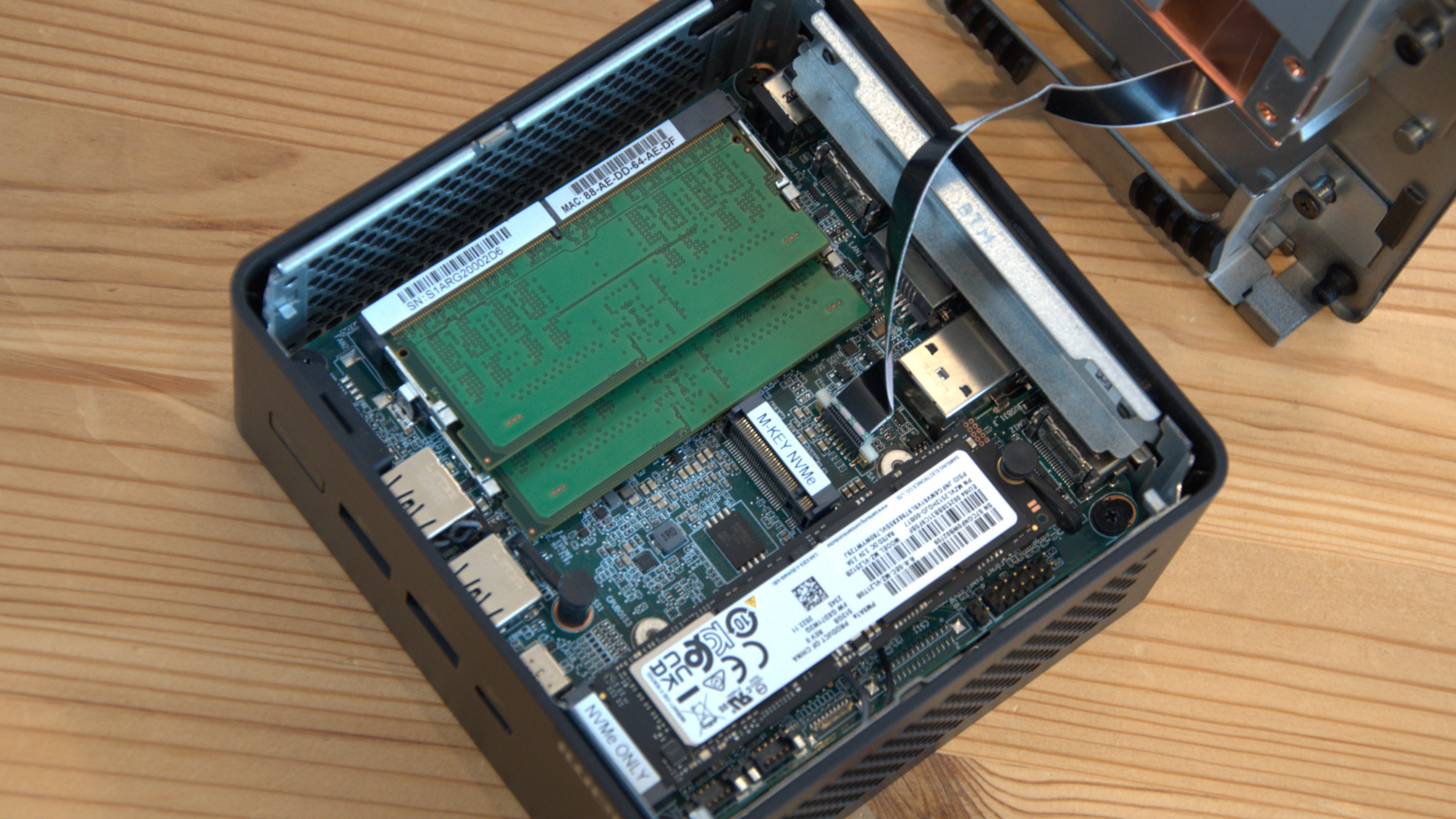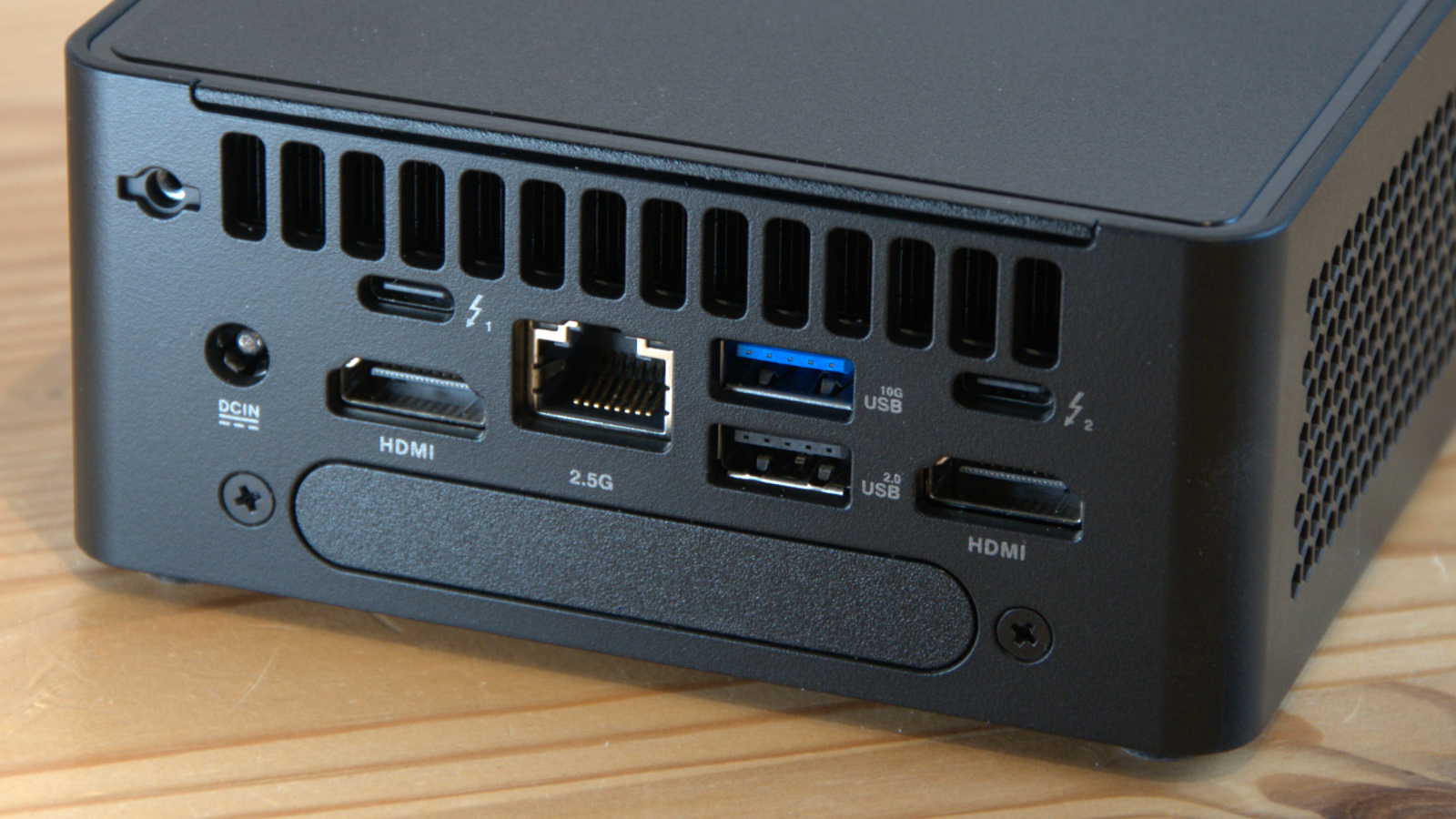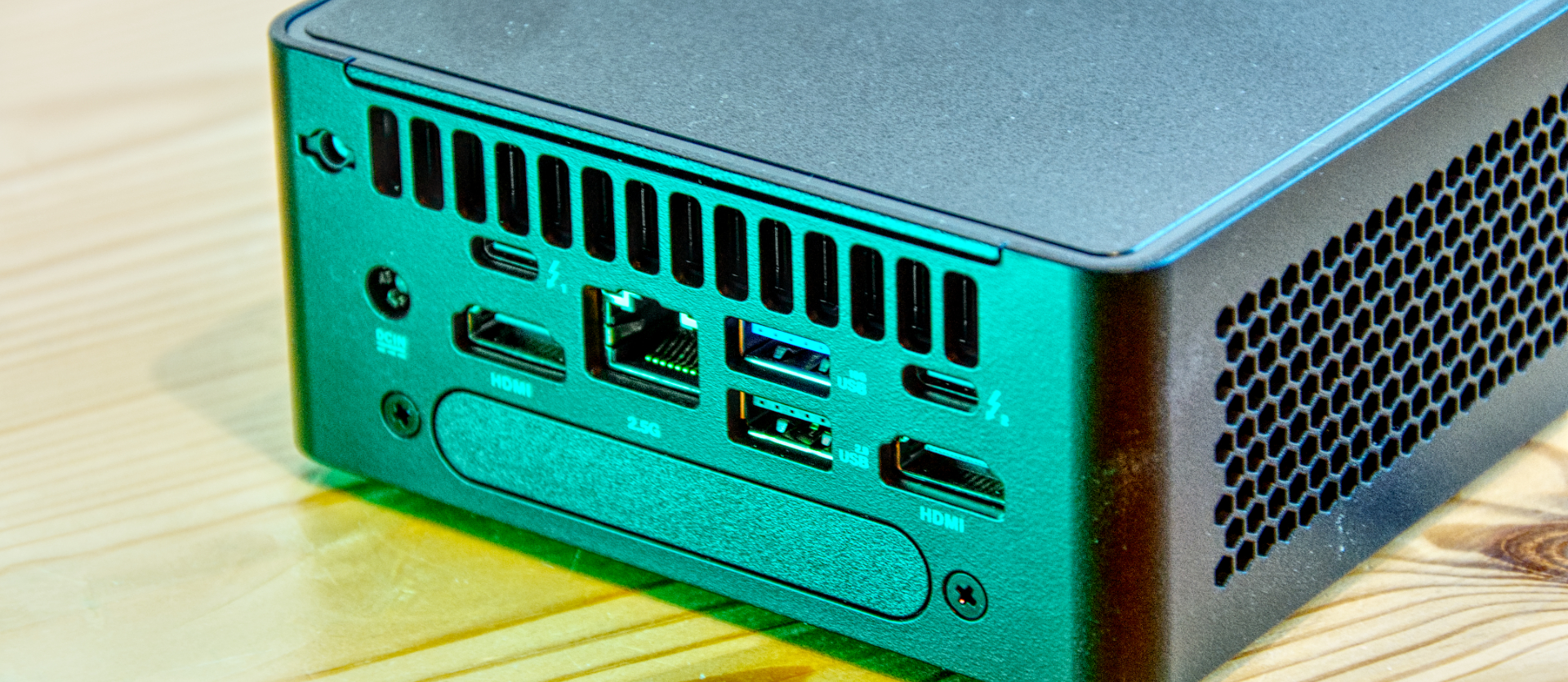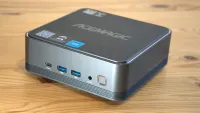TechRadar Verdict
Considering Asus is aiming to replace Intel in the NUC world, the NUC 14 Pro is a bit underwhelming. Besides Thunderbolt, this machine has relatively little special, and its cost is prohibitively high. At this price, it should have been made better.
Pros
- +
Ultra 7 processor
- +
ARC Graphics
- +
Thunderbolt ports
Cons
- -
Plastic case
- -
Lacks an audio jack port
- -
Tool-free Internal access isn’t
Why you can trust TechRadar
30-second review
Since Intel stopped making NUCs with the thirteenth generation Core processors, Asus has taken over the mantle of premium brand and produced the Asus NUC 14 Pro using the new Core Ultra silicon.
Available in a wide range of SKUs, the hardware reviewed here is in an expanded case and features the Intel Core Ultra 7 165H processor with 16GB of DDR5 memory and 512GB of NVMe storage.
The engineers who designed this hardware wanted it to be as flexible as possible so the memory and storage are internally accessible for upgrades. There is also an optional extra daughter board that can be inserted to add extra USB and LAN ports.
We've gone hands-on with loads of the best mini PCs and the NUC 14 Pro is also one of the few Core Ultra systems we’ve seen with Thunderbolt pre-installed. This could be critical for those using it to access external storage or link to another system at high speed.
The downsides to the Asus NUC 14 Pro are that the case is plastic, not metal, and compared with other brands, it is expensive.
With innovative products like the AtomMan X7 Ti coming into the market with even more powerful processors and unique features, Asus may need to do more than the NUC 14 Pro offers and at a more competitive price to convince customers.
Asus NUC 14 Pro: Price and availability
- How much does it cost? From $700
- When is it out? Available now
- Where can you get it? From online retailers
Finding the exact product sent to us for review proved a challenge to buy, as it appears not to be one that Asus is not yet distributing to the retail channels.
Sign up to the TechRadar Pro newsletter to get all the top news, opinion, features and guidance your business needs to succeed!
Most online retailers have the ‘Slim’ models using the Core Ultra 5 processors, but relatively few have the ‘Tall’ design represented by our review NUC14RVH hardware.
The closest that we could find was the ASUS NUC 14 Pro Tall Barebone Kit (RNUC14RVHU70000UI) at B&H Photo Video, which uses the Ultra 7 155H processor and, being a barebones model, comes with no memory or storage for $699.
A populated version using the Core Ultra 5 125H is $869 with 16GB of memory and 512GB of RAM. That would infer that when the hardware we received comes to the shelf, it will be just below or above $1,000. Our guess is $1,100.
Considering the build quality, that’s nearly double what some brands are asking for a comparable machine.
- Value: 3 / 5

Asus NUC 14 Pro: Specs
| Item | Spec |
|---|---|
| CPU: | Intel Core Ultra 7 processor 165H (16 cores, 22 Threads) |
| GPU: | Intel ARC Graphics |
| RAM: | 16GB DDR5-5600 (2800 MHz) (8GB x 2) Expandable to 96GB |
| Storage: | 512TB M.2 2280 PCIe Gen 4 |
| Expansion: | 1x M.2 2230 PCIe Gen 4, 1x SATA 2.5-inch drive (SSD or HDD) |
| Ports: | 2x Thunderbolt 4.0 Type-C, 1x USB 3.2 Gen 2x2 Type-C, 3x USB 3.2 Gen 2 Type-A, 1x USB 2.0, 2x USB 2.0 Headers (internal) |
| Video ports: | 2x HDMI 2.1 |
| Networking: | 1x 2.5GbE LAN, WiFi 6E, Bluetooth 5.2 |
| OS: | Windows 11 Pro (pre-installed) |
| Base Power: | 45W-65W |
| PSU: | 19V 6.32A 120.08W |
| Dimensions: | 117 x 112 x 54(mm) |
Asus NUC 14 Pro: Design
- Plastic
- No audio jack
- Internal access has issues
From the outside, there is very little special about the Asus NUC 14 Pro.
Given how expensive this machine is, the fact that the case is entirely plastic is a little concerning as we expected it to be metal.
The cooling layout is as simple as it gets, with air drawn through the side grills and expelled over the I/O area to the rear. The front offers two USB 3.2 Gen 2 type-A ports along with a single USB 3.2 Gen 2x2 USB-C port.
An apparent missing feature in the front port collection is an audio jack, and it isn’t anywhere else on this PC.
The back has even more USB, dual Thunderbolt 4.0 ports, dual HDMI 2.1 and a single 2.5GbE LAN port. There is also a panel that can be removed to insert a daughter card, which costs another $50 to add a second LAN port and another USB type-A.
That these ports weren’t just included says a lot about Asus these days, but you could just invest the money in a Thunderbolt dock and get many more ports for your cash.
One nice feature we appreciate is that Asus included a power cable clip to prevent the machine from moving and disconnecting. Along with that accessory, the box also included a VESA mounting plate and an FSP-branded 120W PSU.

On the Asus website, much is made about how access is tool-free, even though activating the unlocking mechanism requires a flat screwdriver (not supplied) to rotate it.
Once inside, reveals that Asus hadn’t thought about users going inside at all. The floor plate can’t be easily detached because it is connected to the mainboard using a ribbon cable that connects using one of those incredibly delicate locking mechanisms.
The reason for the ribbon is that the floor of the NUC is a cage for a 2.5-inch SATA drive, so it takes data and power to that device if you install one.
We’ve seen professional repairers break these connectors merely attempting to open them, so the idea that a user, without tools, will detach the ribbon and get it back in without disaster appears to be a shortcut to a refused RMA.
Other disappointments inside are that while the RAM and pre-installed NVMe drive are all fine, the second NVMe slot is only for a 2242-sized module, and neither that nor the 2280 module has any heatsink support.
With many brands offering dual M.2 2280 slots and thermal pads to dissipate heat, Asus engineers have dropped the storage ball entirely.
Overall, this isn’t the best-designed NUC we’ve encountered, and we would have expected better from this brand.
- Design: 3 / 5

Asus NUC 14 Pro: Features
- Intel Core Ultra 7 processor 165H
- 28 PCIe Lanes
- Thunderbolt 4.0
The highlight of this design is the Intel Core Ultra 7 processor 165H, which is remarkably similar to the Core Ultra 9 185H in having 16 cores and 22 threads.
The chosen CPU is a triple core-type design with six performance cores, eight efficiency cores and two low-power efficiency cores, a total of 16. Performance cores are the only ones hyperthreaded, allowing for 22 threads to be processed at once.
Power consumption on this silicon is definable, and Asus went with the 65W cap that most system builders are using. That allows the 120W PSU to handle the system demands and the wattage needed for the Thunderbolt and USB peripherals that are attached.
But the best feature of this platform, and the one that has Mini PC makers clamouring for the Ultra chips, is that it supports 28 PCIe lanes, providing sufficient bandwidth for all the I/O without the need to resort to PCIe switches and other electronic trickery.
The bandwidth can be exploited via the dual Thunderbolt 4 ports, with each supporting 40Gbit/s for external storage, node-to-node connectivity or additional displays.
Another way is that this is one of the first Intel processors to support local AI processing with AI Boost technology. While not many users are currently running local AI applications, this may be something more important in the next few years.
All these Ultra 7 processors come with the ARC Graphics GPU with eight Xe-cores running at 2.3GHz on this option. ARC is a major upgrade over the previous generation Iris Xe GPU and is easily as good as anything that AMD offers in integrated graphics.
With the dual HDMI 2.1 and Thunderbolt ports, it is possible to connect four monitors to the NUC 14 Pro. However, being realistic, ARC Graphics isn’t the equivalent of a modern discrete GPU and won’t support multi-display gaming at high resolution.
Overall, this platform is built for the power user and will eat most office-related tasks for breakfast.

- Features: 4 / 5
Asus NUC 14 Pro: Performance
| Mini PC | Header Cell - Column 1 | Asus NUC 14 Pro | Acemagic F2A | GMKtec K8 |
|---|---|---|---|---|
| CPU | Row 0 - Cell 1 | Intel Core Ultra 7 165H | Intel Core Ultra 5 125H | AMD Ryzen 7 8845HS |
| Cores/Threads | Row 1 - Cell 1 | 16C 22T | 14C 18T | 8C 16T |
| RAM | Row 2 - Cell 1 | 16GB (2x8GB) | 32GB DDR5 (2x16GB) | 32GB DDR5 (2x16GB) |
| Storage | Row 3 - Cell 1 | 512GB Samsung MZVL2512HDJD | 1TB KINGSTON OM8SEP41024Q-A0 | 1TB Lexar NM7A1 |
| Graphics | Row 4 - Cell 1 | Intel Arc Graphics | Intel Arc Graphics | Radeon 780M |
| 3DMark | WildLife | 18683 | 18072 | 16149 |
| Row 6 - Cell 0 | FireStrike | 6827 | 6856 | 7664 |
| Row 7 - Cell 0 | TimeSpy | 3348 | 3424 | 3102 |
| CineBench23 | Single | 1788 | 1651 | 1764 |
| Row 9 - Cell 0 | Multi | 15926 | 14474 | 15691 |
| Row 10 - Cell 0 | Ratio | 8.91 | 8.77 | 8.9 |
| GeekBench | Single | 1813 | 1655 | 1957 |
| Row 12 - Cell 0 | Multi | 12169 | 10442 | 11864 |
| Row 13 - Cell 0 | OpenCL | 30160 | 27553 | 34563 |
| Row 14 - Cell 0 | Vulkan | 27740 | 23474 | 30270 |
| CrystalDisk | Read MB/s | 6626 | 3792 | 5105 |
| Row 16 - Cell 0 | Write MB/s | 4784 | 1627 | 4390 |
| PCMark 10 | Office | 6859 | 6771 | 7396 |
| WEI | Row 18 - Cell 1 | 8.1 | 8.1 | 8.2 |
To see where the NUC 14 Pro came in the greater scope of things, we decided to compare it to the recent Acemagic F2A and the GMKtec K8. The F2A uses the very lowest Core Ultra processor, the Ultra 5 125H, and the K8 is powered by an AMD Ryzen 7 8845HS.
There are two significant takeaways from these results. The first is that ARC Graphics is approaching its limits with the Ultra 5, making the Ultra 7 less impactful on graphics tests than those investing in Asus might have hoped. The difference with the same GPU in the 3Dmark tests was a maximum of 14%, and it even scored worse in the FireStrike result.
But what made this reviewer rub his chin was that in the GeekBench OpenCL and Vulkan tests, the ARC Graphics GPU was overtaken by the Radeon 780M, which is generally considered inferior to ARC Graphics.
This machine reigns supreme in CineBench in both single and multi-core processing, but with so many cores and threads, that should be expected.
Another ray of sunshine here is that Asus used a decent Samsung PM9A1a NVMe drive, elevating its drive performance above the Kingston and Lexar drives on the other machines.
However, the results would have been even better if Asus had sent out an SKU with the 1TB or 2TB versions of this drive for review.
Given the high price that Asus is asking for this hardware, these results are decent but hardly amazing. Both machines used for comparison are significantly cheaper, with the GMKtec K8 being only $650 with twice the memory and storage.
- Performance: 4.5 / 5

Asus NUC 14 Pro: Verdict

Asus wants to take over where Intel left the NUC industry and even use the same naming convention on its products. However, the engineering of the Intel products was significantly better than that of the Asus NUC 14 Pro, which is primarily made of plastic.
They also supplied a review SKU with only 16GB of DDR5 and 512GB, revealing that Asus is at odds with every other NUC supplier’s direction. The standard is now 32GB and 1TB; by the end of this year, it might be more.
That said, at least Ausus included Thunderbolt, a feature that so many NUC makers have decided is a prohibitively costly extra.
The bigger problem with this product is value or, rather, the lack of it. With the likes of Acemagic, GMKtec and Minisforum all playing in the same sandpit with the same silicon, Asus needed to go the extra mile to justify the cost of its equipment but chose not to.
If it had cost less, the plastic enclosure and ribbon cable issues might have been less important, but with Minisforum and others launching metal-cased machines with top-end processors for less, questions need to be asked.
Should I buy a Asus NUC 14 Pro?
| Value | Expensive for the quality of construction on offer | 3/5 |
| Design | Horrible ribbon cable scenario and no audio jack port. | 3/5 |
| Features | Dual M.2 Gen 4 slots, dual Thunderbolt 4.0, but Asus wants extra money for a second 2.5GbE LAN port | 4/5 |
| Performance | A high-performance system, but only just ahead of much cheaper options | 4.5/5 |
| Overalls | Perfect if you use AI and Thunderbolt, but overpriced if you don’t. | 4/5 |
Buy it if...
You need Thunderbolt
Most of the budget NUC builders don’t include Thunderbolt because of the Intel-made chips it requires, but this one has two Thunderbolt 4.0 ports. Those who use this technology will want this NUC.
You want extra performance
This mini-system is remarkably powerful and can handle applications that use multi-threading to improve processing times. It also has AI capabilities if you are using local applications that can harness that power.
Don't buy it if...
You insist on value for money
The cost of Asus machines against identically specified systems made by other brands isn’t a calculation this brand wins. Those who want a powerful NUC can find it elsewhere for dramatically less.
You need more internal storage
The lack of a second M.2 2280 slot limits how much internal storage the NUC 14 Pro can accept. M.2 2242 drives are generally capped at 1TB, so unless you intend to take out the pre-installed drive and swap that to a 4TB, you will be limited in how it can be expanded.
One option is a 2TB SATA SSD, but its performance won’t match the NVMe modules.
- Check out our Asus coupon codes for the latest savings and deals.
Also consider
Acemagic F2A
Using the latest Ultra 5 class processor from Intel with the ARC-integrated GPU, this is another powerhouse solution, but it is from a different stable.
The downsides to this option are that it is more expensive and it doesn’t have USB 4.0 or Thunderbolt. But it’s another powerful small system to consider.
Check out our Acemagic F2A hands on
GMKtec NucBox K8
Uses the latest 8000 series chips from AMD. In most comparisons, the K8 performs not far behind the NUC 14 Pro, and it does have AI processing if you need that functionality, but not Thunderbolt ports.
Check out our GMKtec NucBox K8 review
Mark is an expert on 3D printers, drones and phones. He also covers storage, including SSDs, NAS drives and portable hard drives. He started writing in 1986 and has contributed to MicroMart, PC Format, 3D World, among others.



